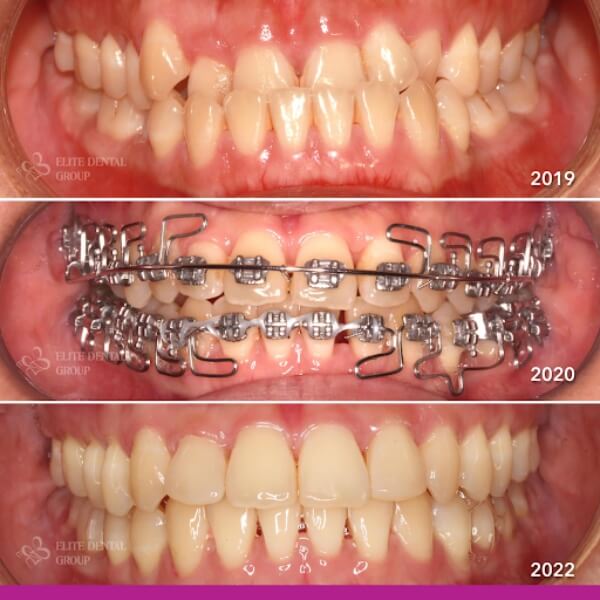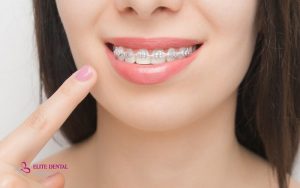Table of content
- 1. What are metal braces?
- 2. Types of metal braces available
- 3. Evaluating the advantages and disadvantages of the method
- 4. Should you get metal braces and who should undergo this treatment?
- 5. How much do metal braces cost?
- 6. How does the metal braces process take place?
- 7. Important notes about metal braces
- 8. Frequently asked questions about metal braces
The cost of metal braces is a common concern, as there are various types of brackets like traditional metal braces, self-ligating metal braces, and lingual metal braces. Check out the detailed pricing information below to help you choose the most suitable option for your needs.
1. What are metal braces?
Metal braces are a fixed orthodontic treatment using metal brackets combined with dental archwires. This system applies force to move misaligned, protruding, or recessed teeth into suitable positions according to the orthodontist’s plan. The treatment aligns the teeth, corrects the bite, and enhances facial harmony.

2. Types of metal braces available
Currently, there are three popular types of metal braces: standard metal braces, self-ligating metal braces, and lingual metal braces.
2.1 Standard metal braces (traditional braces)
Standard metal braces include brackets, archwires, and elastic bands to secure and move the teeth. The elasticity of the bands aids in continuous and stable tooth movement to achieve the desired outcome.
However, since it uses elastic bands, this method is less aesthetic and can experience issues like band stretching or detachment, making cleaning difficult.
2.2 Self-ligating metal braces
Self-ligating metal braces (also known as self-locking or self-closing braces) improve upon traditional braces by using a sliding mechanism within the brackets instead of elastic bands. This ensures continuous tooth movement and minimizes issues such as band stretching or detachment.
2.3 Lingual metal braces
Lingual metal braces (also known as lingual braces) use brackets and wires positioned on the inner side of the teeth, moving them into alignment. The primary advantage of this method is that the braces are hidden, allowing greater confidence during the orthodontic process.
3. Evaluating the advantages and disadvantages of the method
To date, metal braces remain a popular orthodontic method chosen by many. However, before opting for this method, you should consider several advantages and disadvantages as follows:
3.1 Advantages
Let’s explore some outstanding advantages of metal braces:
3.1.1 Low cost, suitable for many people
Compared to other orthodontic methods, the cost of metal braces is usually lower. Therefore, this method is suitable for many people’s financial capabilities, including students.
3.1.2 High orthodontic effectiveness
Metal braces use devices such as brackets, archwires, and others, which are firmly designed to generate stable pulling forces, gradually moving teeth into their correct positions. This helps achieve the desired orthodontic outcomes, addressing issues such as malocclusion, protruding teeth, or overbites.
3.1.3 Relatively short treatment time
Metal braces create relatively strong and stable tightening forces, contributing to a shorter treatment time. However, it should be noted that the treatment duration depends on the severity of dental misalignment, the bite condition, and the orthodontist’s expertise.

3.2 Disadvantages
Besides the advantages mentioned above, metal braces also have some limitations as follows:
3.2.1 Low aesthetics
Metal braces are not as aesthetically pleasing as other methods such as ceramic braces or clear aligners. The metallic color does not match the natural teeth, causing the wearer to feel self-conscious when smiling or communicating.
3.2.2 Discomfort and inconvenience initially
During the initial period of wearing metal braces, you may experience discomfort and feel awkward as you adjust to the braces in your mouth. In some cases, metal brackets may cause irritation to the oral mucosa or tongue. However, this usually subsides after about two weeks as you get accustomed to the braces.
3.2.3 Not suitable for people with metal allergies
Metal braces are not recommended for individuals with metal allergies. Instead, these individuals may consider other alternatives such as ceramic braces or clear aligners.
4. Should you get metal braces and who should undergo this treatment?
Yes, because this is still considered a fundamental orthodontic method that delivers high effectiveness at the most affordable cost. Financially, metal braces are suitable for most people, including students.
Metal braces can be applied to cases requiring orthodontic correction such as:
- Improper bite alignment (malocclusion), jaw misalignment: Deep bite (upper teeth covering ¾ of lower teeth), underbite, crossbite, or open bite.
- Uneven teeth structure: Crowded teeth, gaps between teeth, misaligned teeth, and protruding teeth.

5. How much do metal braces cost?
Below is the latest price list for metal braces at Elite Dental:
| Service | Cost (VND) |
| Metal braces | 60,000,000 – 75,000,000 |
(*) Notes:
- The prices above do not include general dental services.
- The exact cost of metal braces will depend on the condition of the teeth after the dentist’s examination.
- Elite Dental frequently offers promotions and the best prices. Please contact us for the latest updates on ongoing promotions.
6. How does the metal braces process take place?
The process of getting metal braces consists of 6 steps:
Step 1: Consultation and examination with the dentist, followed by X-ray imaging to assess the condition of the teeth.
Step 2: Develop a treatment plan and take dental impressions using plaster to design the braces.
Step 3: Create the braces based on the X-ray results and plaster dental impressions.
Step 4: After about a week, patients receive their braces. At this stage, patients return to have the braces fitted onto their teeth, completing this step.
Step 5: Regular check-ups are conducted to adjust the wires, brackets, and perform necessary procedures like placing mini screws or wearing elastics, typically once a month.
Step 6: Remove the braces and wear a retainer.
To create a detailed, comprehensive, and suitable orthodontic treatment plan for patients, orthodontists must be professionally trained and experienced in orthodontics.
This is why the team of orthodontists at Elite Dental Advanced Orthodontic Center continuously enhances their expertise and knowledge. In addition to their outstanding professional skills, the orthodontists at Elite Dental have over 10 years of clinical experience with both braces and Invisalign. Their understanding of biology and the mechanisms of safe tooth movement ensures the treatment plan is properly directed, closely monitored, and efficiently executed. As a result, patients experience a safe and effective orthodontic journey, achieving a perfect smile upon completion of their treatment.
At Elite Dental, a quality orthodontic journey begins with accurate and comprehensive consultations, offering the most suitable treatment method for each patient’s dental condition while ensuring both oral health and aesthetic outcomes. The treatment process is closely monitored and carefully checked by orthodontists, ensuring progress is steady, changes are positive, and the final results are perfect in terms of lip and facial aesthetics, chewing function, and proper bite alignment.



7. Important notes about metal braces
Here are some key points to keep in mind before and after undergoing orthodontic treatment with metal braces to ensure long-lasting success:
7.1 Before starting treatment
Before starting treatment with metal braces, keep the following in mind:
- Determine whether you are allergic to metal. If so, consult with your orthodontist for other orthodontic methods that do not use metal brackets.
- Visit your orthodontist for a thorough dental check-up and X-ray to understand your current dental condition. Based on this, the orthodontist will develop a tailored orthodontic plan to help you achieve the desired outcome.
7.2 After starting treatment
Here are some tips to help you achieve the best possible results with your braces:
- Attend regular follow-ups as instructed by your orthodontist to monitor your progress and address any issues (if any).
- Brush your teeth at least twice a day and 30 minutes after meals using supportive tools like dental floss and a water flosser to remove food particles and plaque. Regularly clean your teeth to maintain oral hygiene and protect your orthodontic treatment journey.
- Avoid hard, chewy, or highly pigmented foods.
- If a bracket falls off or loosens, visit your orthodontist as soon as possible.
- After completing your braces treatment, wear retainers for the period recommended by your orthodontist and monitor your dental condition closely.
- If any abnormality or shifting occurs after braces, consult your orthodontist immediately to determine the cause and develop a suitable solution.
8. Frequently asked questions about metal braces
Here are some common questions that patients often ask before undergoing orthodontic treatment with metal braces:
8.1 Why are self-ligating metal braces more expensive than traditional braces?
Self-ligating braces are more expensive because they have an automatic mechanism that holds the archwire in place, reducing friction, allowing teeth to move more easily, and shortening the treatment time.
8.2 Do metal braces hurt?
During the treatment, you may experience discomfort or soreness due to the pressure from the orthodontic appliances. However, this is normal and typically lasts only a few days as you adjust. Choosing a high-quality orthodontic provider ensures precise calculations of bracket force, minimizing pain and discomfort.

8.3 Can I fly with metal braces?
You can travel by plane while wearing metal braces. The brackets and wires are made of metal, but the content is below the threshold that would set off airport metal detectors (below level 4).
8.4 What should I do if a bracket falls off?
If a bracket becomes loose, remain calm, use orthodontic wax to temporarily secure it, and visit your orthodontist as soon as possible for repair. If a bracket falls off completely, store it in a container and bring it to your orthodontist for reattachment.
These are useful details about the cost of metal braces and important considerations to keep in mind. If you have any further questions about metal braces, please contact Elite Dental at (+84) 902 661 100 for detailed advice about the cost and process of metal braces treatment, as well as suggestions for suitable orthodontic methods.
>>Related posts: At What Age Should Children Get Braces? Advices from Orthodontists







